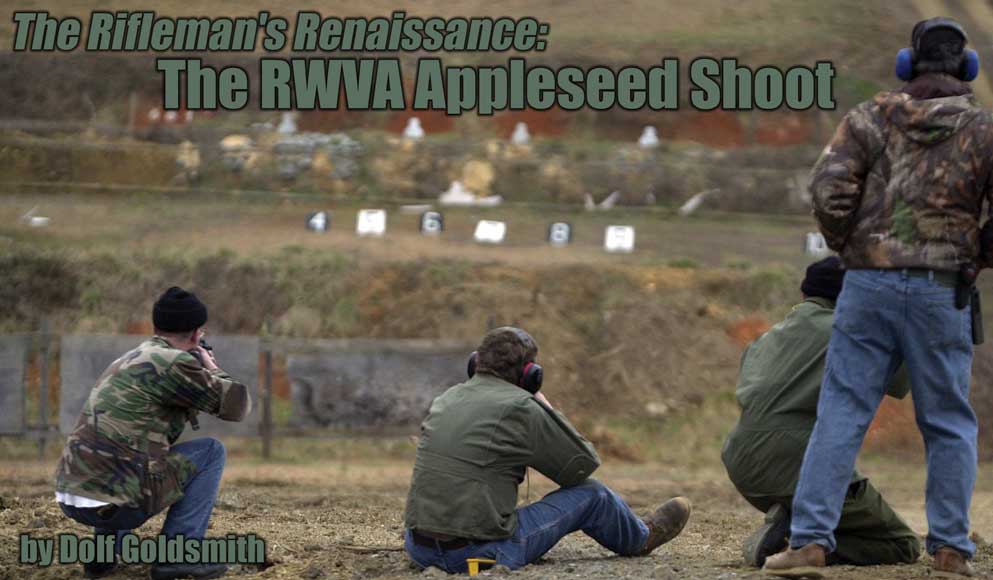RWVA match competitors firing at 200 yards in the squatting, sitting and kneeling positions. This photo was taken at the RWVA home range in Ramseur, North Carolina. Note the Army train fire targets in the distance. (Photo by Harry Lynch, RWVA)
By Dolf Goldsmith
In March, 2004 a few dedicated rifle shooters from Ramseur, North Carolina assessed the ability of our nation’s people to be able to shoot military style rifles fast and accurately. They found that the United States, which was at one time hailed as a “nation of rifleman” was sadly wanting in this respect. Many of our military units are well trained in shooting but they are the exception rather than the rule.
How different this is from the days of the Boxer rebellion in the summer of 1900, when the Chinese were fighting against troops from many foreign powers. Then when they suddenly started taking a lot of casualties, they would say, “We must now be up against Americans.”
Today, only Switzerland and Norway can still be said to be “Nations of Riflemen”. In those countries, everyone is trained to shoot fast and accurately, the part time soldiers all have to qualify every year, and everyone is in the part time Army, Navy, or Air Force. In addition, everyone keeps their weapon and ammunition at home.
After assessing this situation, this small group of North Carolinians decided to do something about it. Three of them founded the RWVA which stands for Revolutionary War Veterans Association.
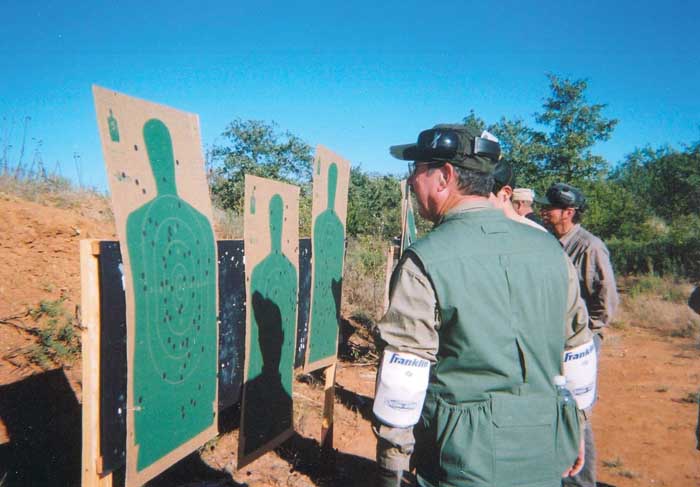
Why reference to the Revolutionary War? That is when America’s tradition as a nation of rifleman began. As one of the RWVA slogans says, “August 19, 1775 – when marksmanship met history and liberty began.”
Then, why the name “The Appleseed” shoot? John Chapman, who was born in 1774 in Massachusetts, became an accomplished nurseryman, moved west in 1792, and started planting apple seeds all over Ohio, Indiana and Illinois. The popular image of John Chapman had him planting seeds randomly everywhere he went. Actually, he planted nurseries rather than orchards, built fences around them to protect them from livestock and then left the nurseries in care of neighbors who sold the young trees to growers. John would return every year or two to see that all was in order and obtain the money for the trees that had been sold. He was able to obtain the apple seeds free from the cider mills who wanted more apple trees planted as this eventually would bring them more business. In time he became popularly known as Johnny Appleseed. Johnny Appleseed died in 1845 having devoted his entire life to proliferating apple trees. He never made much money, and what he did make, he gave away. His whole mission in life was to promote the growing of apple trees.
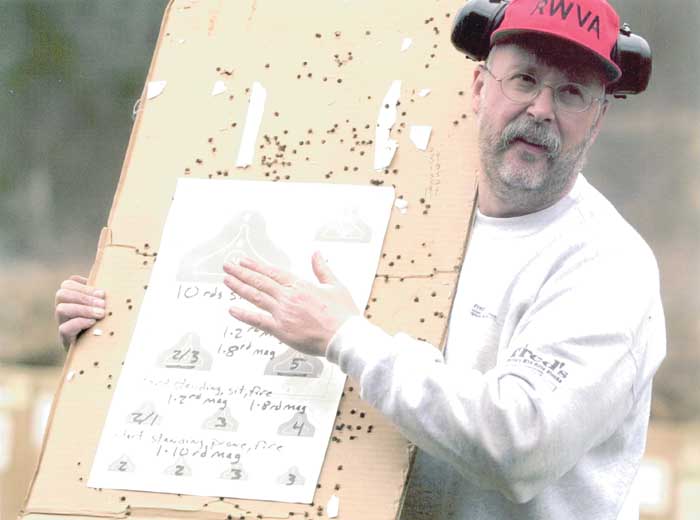
From Johnny Appleseeds’ story the idea of how to promote rifle shooting and have it proliferate was born. Similarly the concept of the RWVA is to train not only riflemen but to train instructors who can teach others to be riflemen, with the goal of making America once again a “Nation of Riflemen.” Thus their shooting program is set up with this in mind.
What is a rifleman? Is he just some guy in the infantry who is issued a rifle, has some rudimentary training and goes out into battle so often woefully unable to hit the enemy? His army MOS (Military Occupational Specialty) calls him a rifleman but he is far from it. It’s not his fault because the hurried nature of our participation in war often does not allow sufficient training time for him to become proficient. Nor, is a rifleman an individual who goes into the woods or out on the desert and plinks away at tin cans with a .22. He also generally does not have the shooting skills that make a rifleman. How much better would it have been if our young men had already been properly trained in military style rifle shooting before they went into the armed forces?
So what is a rifleman? The dictionary gives two definitions: 1) a soldier armed with a rifle, and 2) a man skilled in the use of a rifle. We all now know it’s not No.1, but No. 2. The RWVA has stated that the true measure of a rifleman is not how fast he can shoot, but how many hits he can make in any given period of time, the faster the better.
A true rifleman takes up any sighted rifle and hits a man sized target at 500 yards. In the old days this was called the “Rifleman’s Quarter Mile” and the true rifleman was expected to control any visible target within that 500 yard radius.
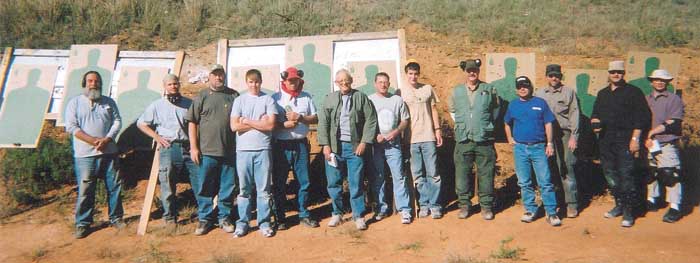
A man sized target is about 20 inches wide and just over 20 inches high, so to be effective one must keep his shots within a 20 inch circle. This is in effect a 4 minute of angle group. One minute of angle equals one inch at 100 yards. Theoretically, not allowing for the wind factor, he has to be able to shoot 4 minute groups at 100 yards in order to remain within a 20 inch circle at 500 yards, and if we bring that figure down to 400 yards, he has to be able to shoot five inch groups at 100 yards. At 500 or even 400 yards the wind factor is much more than at 100 yards, so if the shooter can shoot 3 inch, or even 2 inch groups at 100 yards, so much the better.
The Army has developed a series of targets to be fired at 25 meters. These are reduced size targets that correspond with distances as they appear at 100, 200, 300 and 400 meters, the ranges at which soldiers must be able to shoot and hit.
The Appleseed shoots start out on these 25 meter qualification targets, which are abbreviated as the AQT. After the shooter has shown proficiency on these targets he can go on to firing at actual 100, 200, 300 and 400 meters, or yards targets, as the range distances may be laid out.
The 25 meter (82 feet) course consists of 4 stages:
- Stage one is fired standing, 10 rounds in 2 minutes on a target that represents the standard Army “D” target at 100 meters.
- Stage two is fired sitting (starting from standing) 10 rounds with one magazine change in 50 seconds on a target that represents the standard Army “D” target at 200 meters.
- Stage three is fired prone (from standing) 10 rounds with one magazine change in 60 seconds on a target that represents the standard “D” target at 300 meters.
- Stage four is fired prone 10 rounds in 5 minutes on a target that represents the Army “D” target at 400 meters.
This is the most difficult stage as the aiming mark, and also, the scoring rings on the target are so small.
After the shooter becomes proficient, the course turns to the “Rapid Fire AQT”. This comprises the above four stages fired one after the other straight through in a total time limit of five minutes.
In both the slow and rapid fire AQT exercises the score of the 10 shots on the difficult stage 4 is doubled to represent 20 rounds. The entire course then allows a total possible score of 250 points, 210 rounds are required to qualify as a rifleman.
This course of fire is somewhat similar to that fired at the National Rifle Association high power rifle matches.
Based on the shooters record on the AQT, he can be awarded the coveted rifleman’s badge to be worn on the shooters jacket. This is equivalent to the Army Expert Rifleman’s qualification badge.
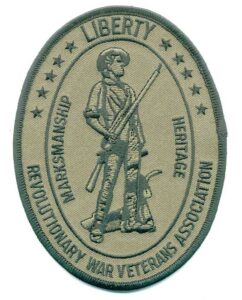
The badge of the Revolutionary War Veterans Association. 
The coveted “Rifleman” badge issued to qualified riflemen. This equivalent to scoring Expert in the Army.
The RWVA has developed a “classification” AQT where in 8 rounds you can get a quick measure of your skills as they are now in comparison to the army standard, as well as a new “Hits Count” redcoat target where in 12 rounds you can answer the question “How far away, with my current rifle skills, can I be effective on a target.”
Needless to say, all applicable firearms safety procedures are heavily stressed and strictly enforced during the RWVA events.
In just over one year, the RWVA has safely held and successfully conducted 18 Appleseed Tour Engagements in 14 states, and heaven only knows how many Mini-Appleseeds – thanks to all of the “mini” instructors.
Additionally, many one-day marksmanship events were held at the home range in Ramseur, and the first six-day rifleman’s Bootcamp. Through those events they have delivered more than 1,000 person/days in basic safety and marksmanship training, producing more than 900 students and numerous qualified instructors. No fewer than 26 Appleseed events were scheduled for 2007 in 19 states and at least three bootcamps were planned.
The RWVA website is in the process of being updated, and the RWVA forum itself is tracking at more than 15,000 posts and over 1.2 million page views total. The RWVA weblog is averaging 77 unique hits per day, with average visit length of over 5 minutes and total unique visitors at nearly 56,000.
For those not familiar with RWVA’s on-line world, the RWVA website (www.rwva.org) serves as a hub for the other parts of the virtual organization. The forum at http://www.rwva.org/yabbse is a place where the members and guests can share what they have learned about marksmanship and history. The weblog, or “blog”, at http://rwva.blogspot.com, contains online basic riflery instruction, plus a wide variety of resources to be used in educating and communicating to others about the Second Amendment and Revolutionary War history.
The following 2007 listing is shown to give an idea of the diversity of locations where Appleseed shoots were held: Bloomington, IL; Bozeman, MT; Evansville, IN; Langhorne, PA; Kooskia, ID; Medford, OR; Coeur d’Alene, ID: Osage Beach, MO; Phoenix, AZ; Ramseur, NC; Mingus, TX; Stuart, VA; Taccoa, GA; and Yakima, WA.
Current information is available on their website. Whereas Johnny Appleseed covered only Ohio, Indiana, and Illinois, the Appleseed shoot covers the whole country.
The author participated in the Appleseed shoot in Mingus, Texas and found it extremely worthwhile and liked the program so much he signed up for it himself. Even though he has been a rifle shooter all his life he learned a number of useful pointers he was not aware of. The instructors at the RWVA are extremely knowledgeable and capable. The 54 page booklet entitled Fred’s Guide to Becoming a Rifleman available from Fred’s Military M14 Rifle Stocks, P.O. Box 629, Ramseur, N.C. 27316 is well put together with a lot of useful information.
The RWVA’s mission concerns itself with, and this is what they will tell you, (stated in their own words:)
- To Shoot
- To Recruit
- To Educate
- To Communicate
That’s all. Four simple steps towards a more informed America, each performed publicly in the full light of day.
“We use a relentless application of the basics marksmanship and safety education, letters to the editor, encouragement to and from like-minded Second Amendment allies, and voting.
In-short, free speech and informed voting – the most all-American acts of all. By fighting and winning the political soft war being waged against the Second Amendment, via the soap box and the ballot box, law-abiding American men and women will someday soon be able to gather at a local range to shoot and discuss the world. We’re proud to be part of the struggle to make that “someday” be tomorrow. We’re the RWVA – farmers, teachers, lawyers, mothers, truck drivers, accountants, artists, doctors, businessmen, students, engineers – everyday American men and women dedicated to a renaissance of traditional marksmanship and the study of American history.
RWVA members make a concrete contribution to saving riflery and freedom in this country. Your modest $20 annual dues will help keep the Appleseed Program on the road for the duration, as well as contribute to the upkeep at the Ramseur home range – one of the finest civilian rifle ranges in the country.
| This article first appeared in Small Arms Review V11N10 (July 2008) |



